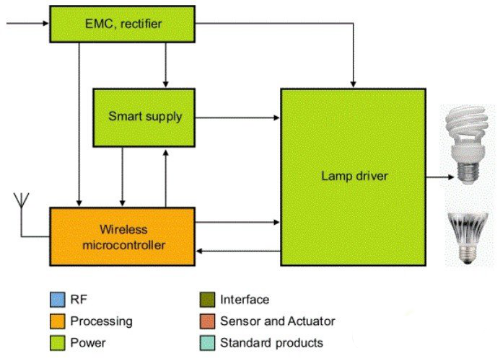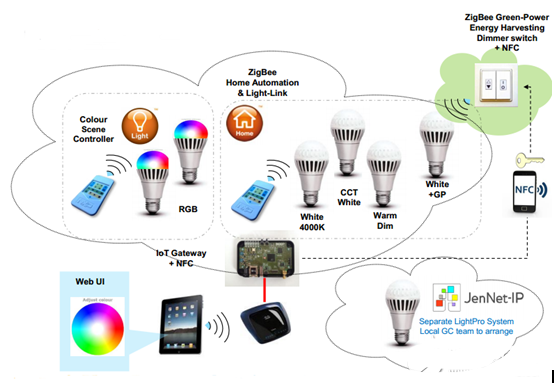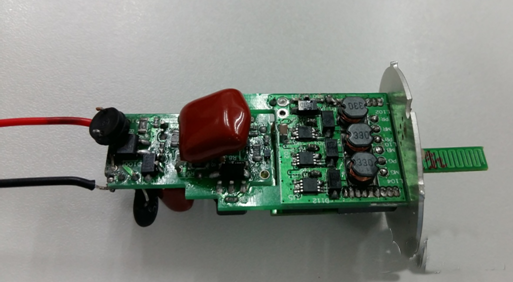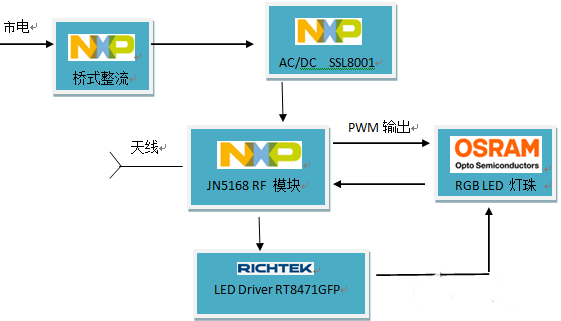With the development of the IOT industry, intelligent LED lighting has become an important part of the IOT. As the capabilities of mobile devices continue to escalate, the use of wireless methods to control lighting is a direction for smart lighting in the future. In particular, remote control will bring a lot of convenience to the user. For example, it is also possible to check whether the lamp at home is related to work, and to control it.
NXP offers fully integrated solutions for automotive solid state lighting applications. These include the ASLxxxx family of multi-channel LED drivers, which are fully integrated solutions that guarantee system flexibility and stability for automotive LED lighting applications. In addition, the TDA3629 headlight position controller is available to support adaptive beam adjustment solutions. Both solutions significantly improve system performance and minimize the overhead associated with different applications.
LED Driver ICs and Lamp Position Controllers The NXP ASLxxxx family of LED driver ICs are automotive-specific application-specific standard products that provide a fully integrated solution for automotive LED lighting applications. Not only does it provide the functionality needed for today's and tomorrow's automotive LED applications, it also maintains system flexibility, supports design reuse, and is highly scalable and cost effective. The light level controller is a monolithic integrated circuit for passenger cars that adjusts the beam height of the headlights of the car to a state defined by the driver of the vehicle through a potentiometer on the instrument panel.
The driver simply adjusts the height by simply selecting a new position, and the TDA3629 activates the control motor to increase or decrease its beam angle. Its low positional error allows the driver to accurately position his headlight beam, maximizing the road and not glaring any oncoming vehicles. This device prevents the temperature from rising to 160 . Above C and electrical transients, it also has undervoltage/overvoltage protection and broken wire detection.
The ASLxxxx family of LED drivers is a versatile, application-specific, constant current, high brightness LED driver IC. They provide a fully integrated solution for automotive LED lighting applications that maintains system flexibility, supports design reuse, and enables high scalability of low-cost solutions. The main features are three:
First, lower system costs. The NXP Drive IC portfolio is designed to achieve maximum design freedom in initial design, volume production and future system upgrades at the lowest cost. The portfolio includes two families - the Multi-Phase Boost ASLx500 and the Multi-Channel Step-Down ASLx416 Driver IC. In addition, they provide a unified platform architecture that can drive any number of LEDs and channels while reducing system cost.
Second, there is less space. The high degree of digital integration ensures the minimum number of external components for maximum durability and design simplicity. In addition, NXP's multi-channel buck IC uses an external power MOSFET for each channel. This achieves the best thermal performance of the driver at high currents (more than 1.5A per channel). As a result, NXP's multi-channel LED driver ICs deliver high output power with minimal PCB area without the need for expensive heat sink components.
Third, shorten the R&D production cycle. NXP's multi-channel LED driver ICs are highly scalable and flexible. The NXP solution has a boost IC that can scale from dual to 12 channels with output power between 30 W and 140 W. In addition, through the SPI interface, NXP driver ICs can be flexibly programmed to enable NXP solutions to drive a variety of advanced lighting applications such as adaptive high beam illumination (ADB), advanced headlight illumination (AFL), laser illumination, etc. . NXP's solutions also feature optimized architecture, packaging and leads to shorten the R&D production cycle for new product development and future product upgrades.
NXP GreenChip Intelligent Lighting Solutions NXP's GreenChip Smart Lighting Solutions offer new features in a compact, low-cost, wireless IP connection, energy-efficient lighting and low standby power consumption (currently 150mW, planned to be reduced to 50mW) Control and energy management methods.
Wireless microcontroller:
Smart supply: TEA1721AT, TEA1721BT, TEA1721DT,
Key Features and Benefits 1. Flexible, easy to expand and affordable software solution 2. Highly secure IP intelligent lighting system with JenNet-IP software stack with secure debugging/communication capabilities 3. Supports up to 500 nodes with powerful Network self-healing and readjustment capabilities 4. Full range of NXP products such as lighting drivers, AC/DC converters, high-performance IEEE 802.15.4 single-chip transceivers and MCUs ensure the flexibility of the solution for remote control of intelligent lighting by battery Powered remote wireless communication provides an easy and flexible way to control luminaires in a home environment.
Based on the NXP 's 32-bit low-power wireless microcontroller JN516X series, the NXP JN5168 RGB LED lamp driver solution can perfectly realize the intelligent illumination RGB (W) lamp solution, using Zigbee technology to achieve the common RGB (W) LED lamp. In addition to dimming, grouping, and scene mode control of smart light bulbs, different color control of LED lights can be realized, enriching the experience of different application scenarios of users.
 Â
1 110 or 230 V AC input 2 18.3V , 0.4A output 3 RGB tri-color plus white dimming 4 support zigbee and zigbee Light Link / Zigbee HA / JenNet-IP protocol dimming 6 support for mobile or tablet app or web UI Interface control or remote control control [scheme characteristics]
1 Wireless dimming control with NXP JN5168 Zigbee chip 2 NXP SSL8001T High efficiency 3 Power factor 4 Low standby power 5 Lamp power can be adjusted according to the number of LED beads. Summary: All NXP multi-channel automotive LED drivers are very small HVQFN32 pin package. Specialized support for high-brightness and smart LED solutions for more upgrades to traditional automotive lighting solutions. In addition, key control parameters such as output current and control loop compensation can be programmed through the SPI interface. The driver IC also achieves higher integration, significantly lower system cost, and improved design freedom.
NXP offers fully integrated solutions for automotive solid state lighting applications. These include the ASLxxxx family of multi-channel LED drivers, which are fully integrated solutions that guarantee system flexibility and stability for automotive LED lighting applications. In addition, the TDA3629 headlight position controller is available to support adaptive beam adjustment solutions. Both solutions significantly improve system performance and minimize the overhead associated with different applications.
LED Driver ICs and Lamp Position Controllers The NXP ASLxxxx family of LED driver ICs are automotive-specific application-specific standard products that provide a fully integrated solution for automotive LED lighting applications. Not only does it provide the functionality needed for today's and tomorrow's automotive LED applications, it also maintains system flexibility, supports design reuse, and is highly scalable and cost effective. The light level controller is a monolithic integrated circuit for passenger cars that adjusts the beam height of the headlights of the car to a state defined by the driver of the vehicle through a potentiometer on the instrument panel.
The driver simply adjusts the height by simply selecting a new position, and the TDA3629 activates the control motor to increase or decrease its beam angle. Its low positional error allows the driver to accurately position his headlight beam, maximizing the road and not glaring any oncoming vehicles. This device prevents the temperature from rising to 160 . Above C and electrical transients, it also has undervoltage/overvoltage protection and broken wire detection.
The ASLxxxx family of LED drivers is a versatile, application-specific, constant current, high brightness LED driver IC. They provide a fully integrated solution for automotive LED lighting applications that maintains system flexibility, supports design reuse, and enables high scalability of low-cost solutions. The main features are three:
First, lower system costs. The NXP Drive IC portfolio is designed to achieve maximum design freedom in initial design, volume production and future system upgrades at the lowest cost. The portfolio includes two families - the Multi-Phase Boost ASLx500 and the Multi-Channel Step-Down ASLx416 Driver IC. In addition, they provide a unified platform architecture that can drive any number of LEDs and channels while reducing system cost.
Second, there is less space. The high degree of digital integration ensures the minimum number of external components for maximum durability and design simplicity. In addition, NXP's multi-channel buck IC uses an external power MOSFET for each channel. This achieves the best thermal performance of the driver at high currents (more than 1.5A per channel). As a result, NXP's multi-channel LED driver ICs deliver high output power with minimal PCB area without the need for expensive heat sink components.
Third, shorten the R&D production cycle. NXP's multi-channel LED driver ICs are highly scalable and flexible. The NXP solution has a boost IC that can scale from dual to 12 channels with output power between 30 W and 140 W. In addition, through the SPI interface, NXP driver ICs can be flexibly programmed to enable NXP solutions to drive a variety of advanced lighting applications such as adaptive high beam illumination (ADB), advanced headlight illumination (AFL), laser illumination, etc. . NXP's solutions also feature optimized architecture, packaging and leads to shorten the R&D production cycle for new product development and future product upgrades.
NXP GreenChip Intelligent Lighting Solutions NXP's GreenChip Smart Lighting Solutions offer new features in a compact, low-cost, wireless IP connection, energy-efficient lighting and low standby power consumption (currently 150mW, planned to be reduced to 50mW) Control and energy management methods.

Wireless microcontroller:
Smart supply: TEA1721AT, TEA1721BT, TEA1721DT,
Key Features and Benefits 1. Flexible, easy to expand and affordable software solution 2. Highly secure IP intelligent lighting system with JenNet-IP software stack with secure debugging/communication capabilities 3. Supports up to 500 nodes with powerful Network self-healing and readjustment capabilities 4. Full range of NXP products such as lighting drivers, AC/DC converters, high-performance IEEE 802.15.4 single-chip transceivers and MCUs ensure the flexibility of the solution for remote control of intelligent lighting by battery Powered remote wireless communication provides an easy and flexible way to control luminaires in a home environment.


Based on the NXP 's 32-bit low-power wireless microcontroller JN516X series, the NXP JN5168 RGB LED lamp driver solution can perfectly realize the intelligent illumination RGB (W) lamp solution, using Zigbee technology to achieve the common RGB (W) LED lamp. In addition to dimming, grouping, and scene mode control of smart light bulbs, different color control of LED lights can be realized, enriching the experience of different application scenarios of users.


 Â

1 110 or 230 V AC input 2 18.3V , 0.4A output 3 RGB tri-color plus white dimming 4 support zigbee and zigbee Light Link / Zigbee HA / JenNet-IP protocol dimming 6 support for mobile or tablet app or web UI Interface control or remote control control [scheme characteristics]
1 Wireless dimming control with NXP JN5168 Zigbee chip 2 NXP SSL8001T High efficiency 3 Power factor 4 Low standby power 5 Lamp power can be adjusted according to the number of LED beads. Summary: All NXP multi-channel automotive LED drivers are very small HVQFN32 pin package. Specialized support for high-brightness and smart LED solutions for more upgrades to traditional automotive lighting solutions. In addition, key control parameters such as output current and control loop compensation can be programmed through the SPI interface. The driver IC also achieves higher integration, significantly lower system cost, and improved design freedom.
0 times
Window._bd_share_config = { "common": { "bdSnsKey": {}, "bdText": "", "bdMini": "2", "bdMiniList": false, "bdPic": "", "bdStyle": " 0", "bdSize": "24" }, "share": {}, "image": { "viewList": ["qzone", "tsina", "tqq", "renren", "weixin"], "viewText": "Share to:", "viewSize": "16" }, "selectShare": { "bdContainerClass": null, "bdSelectMiniList": ["qzone", "tsina", "tqq", "renren" , "weixin"] } }; with (document) 0[(getElementsByTagName('head')[0] || body).appendChild(createElement('script')).src = 'http://bdimg.share. Baidu.com/static/api/js/share.js?v=89860593.js?cdnversion=' + ~(-new Date() / 36e5)];
Temperature Sensor,Ambient Temperature Sensor,Air Temperature Sensor,Fuel Temperature Sensor
Xiaogan Yueneng Electronic Technology Co., Ltd. , https://www.xyeloadcell.com